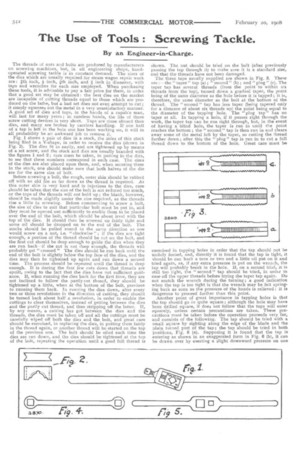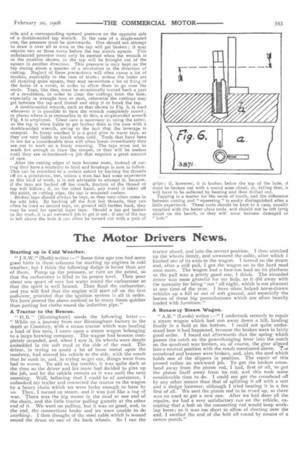The Use of Tools : Screwing Tackle.
Page 26

Page 27

If you've noticed an error in this article please click here to report it so we can fix it.
By an Engineer-in-Charge.
The threads of nuts and bolts are produced by manufacturers on screwing machines, but, in all engineering shops, handoperated screwing tackle is in constant demand. The sizes of the dies which are usually required for steam wagon repair work are : gth inch, inch,L=th inch, and inch in diameter, with taps and wrenches for each size employed. When purchasing these tools, it is advisable to pay a fair price for them, in order that a good set may be obtained: the best dies on the market are incapable of cutting threads equal to those which are produced on the lathe, but a bad set does not even attempt to cut; it simply squeezes out the metal in a very unsatisfactory manner. A good set of dies and taps, in the hands of a capab:e man, will last for many years ; in careless hands, the life of these screw cutting devices is very short. Taps are more abused than dies, and many are broken by careless handling. If one half of a tap is left in the hole one has been working on, it will in all probability be an awkward job to remove it. Fig. 1 shows a pair of dies in a stock, the sides of this stock being filed in a V-shape, in order to receive the dies (shown in Fig. 2). The dies fit in easily, and are tightened up by means of a set screw, and the stock and dies are usually branded with the figures 1 and 2; care must be taken, in putting in the dies, to see that these numbers correspond in each case. The sizes of the dies are also placed upon them, and, when securing them in the stock, one should make sure that both halves of the die are for the same size of bolt.
Before screwing a bolt, the rough, outer skin should be rubbed off with an old file as far down as the thread is required. As this outer skin is very hard and is injurious to the dies, care should be taken that the size of the bolt is not reduced too much, or the tops of the threads will not hold up ; the blank, however, should be made slightly under the size required, as the threads rise a little in screwing. Before commencing to screw a bolt, the size of dies to suit that particular bolt must be put in, and they must be opened out sufficiently to enable them to be placed over the end of the bolt, which should be about level with the top of the dies. It should then be screwed up fairly tight and some oil should be dropped on to the end of the bolt. The stocks should be pulled round in the same direction as one would screw on a nut, i.e. "clockwise" ; if the dies are tight enough, a portion of the thread should be cut on the bolt, and the first cut should be deep enough to guide the dies when they are run back—if the cut is not deep enough, the threads will 'probably get "crossed " The dies should be run back until the end of the bolt is slightly below the top face of the dies, and the dies may then be tightened up again and run down a second time. The process should be repeated until the thread is deep enough. It is during the first few cuts down that threads are spoilt, owing to the fact that the dies have not sufficient guidance. If, when running the dies back for the first time, they are not inclined to follow the partly cut thread, they should be tightened up a little, when at the bottom of the bolt, previous to running them back. In running the dies down, after every two or three revolutions in the direction of cutting, they should be turned back about half a revolution, in order to enable the cuttings to clear themselves, instead of getting between the dies and the partly cut thread, and thus stripping off the latter. If, by any means, a cutting has got between the dies and the threads, the dies must be taken off and all the cuttings must be carefully wiped off both the dies and the bolt, and great care should be exercised, in replacing the dies, in putting them fairly in the thread again, or another thread will be started on the top of the previous one. The bolt should be oiled each time the dies are run down, and the dies should be tightened at the top of the bolt, repeating the operation until a good full thread is
shown. The nut should be tried on the bolt (after previously passing the tap through it) to make sure it is a standard size, and that the threads have not been damaged.
The three taps usually supplied are shown in Fig. B. These are :—the " taper" tap (a) ; "second" (b); and " plug" (c). The taper tap has several threads (from the point to within six threads from the top), turned down a gradual taper, the point being of the same diameter as the bole before it is tapped; it is, therefore, the same diameter as the bolt at the bottom of the thread. The " second " tap has less taper (being tapered only for a distance of about six threads up) the point being equal to the diameter of the tapping hole. The "plug tap" has no taper at all. In tapping a hole, if it passes right through the work, the taper tap can be run right through, but, in the event of having a blind hole, the taper is run in until the point reaches the bottom ; the " second" tap is then run in and clears away some of the metal left by the taper, so cutting the thread further down; after this the " plug " tap is run in to cut a full thread down to the bottom of the hole. Great care must be exercised in tapping holes in order that the tap should not be unduly forced, and, directly it is found that the tap is tight, it should be run back a turn or two and a little oil put on it and tried again, as, if any extra pressure is put on the wrench, the tap will probably break in the hole. If, on a second trial, it is still too tight, the "second" tap should be tried, in order to ease off the upper threads before trying the taper tap again. Do not snatch the wrench during the turning; a good indication when the tap is too tight is that the wrench may be felt springing back as soon as the pressure of the hands is relieved : it is dangerous to proceed further than this point.
Another point of great importance in tapping holes is that the tap should go in quite square; although the hole may have been drilled square, it does not follow that the taps will enter squarely, unless certain precautions are taken. These precautions must be taken before the operation proceeds very far, and consists of the following. The tap should be tried with a small square by sighting along the edge of the blade and the plain turned part of the tap ; the tap should be tried in both positions, Fig. 6 (a). Supposing it is found that the tap is entering as shown in an exaggerated form in Fig. 6 (b), it can be drawn over by exerting a slight downward pressure on one side and a corresponding upward pressure on the opposite side of a double-ended tap wrench. In the case of a single-ended one, the pressure must be downwards. One should not attempt to draw it over all at once or the tap will get broken ; it may require two or three turns before the tap stands square. This unbalanced pressure must only be exerted when the wrench is in the position shown, or the tap will be brought out of the square in another direction. This pressure is only kept on the tap during about a quarter of a revolution in the direction of cutting. Neglect of these precautions will often cause a lot of trouble, especially in the case of studs; unless the latter are all standing quite square, they may necessitate a lot of filing of the holes of a cover, in order to allow them to go over the studs. Taps, like dies, must be occasionally turned back a part of a revolution, in order to clear the cuttings from the hole, especially in wrought iron or steel, otherwise the cuttings may get between the tap and thread and strip it or break the tap. A double-ended wrench, such as that shown in Fig. 5, is used whenever it is possible to turn the wrench completely round ; in places where it is impossible to do this, a single-ended wrench Fig. 4 is employed. Great care is necessary in using the latter, as the tap is more liable to get broken than is the case with a double-ended wrench, owing to the fact that the leverage is unequal. In frosty weather it is a good plan to warm taps, as they are very liable to break when cold. Tools that have been in use for a considerable time will often break immediately they are put to work on a frosty morning. The taps must not be made hot enough to draw the temper, or they will be useless until they are re-hardened—a job that requires a great amount of care.
After the cutting edges of taps become worn, instead of cutting they have a tendency to bind and breakage is sure to follow. This can be remedied to a certain extent by backing the threads off on a grindstone, but, unless a man has had some experience at this kind of work, it is not advisable to attempt it, because, if the taps are backed off too much, fracture of the thread or tap will follow ; if, on the other hand, any metal is taken off the point, or cutting edge, the tap is rendered useless.
Broken taps should always be kept, as they very often come in for odd jobs. By backing off the first few threads, they can often be used as second taps, or, ground still further back, they may be used for special taper taps. Should a tap get broken in the work, it is an awkward job to get it out : if any of the tap is left above the hole it can often be turned out with a pair of
grips; if, however, it is broken below the top of the hole, it must be broken out with a round nose chisel, or, failing that, it will have to be softened by heating and then drilled out.
Tapping is a matter for the sense of touch, and the difference between cutting and " squeezing " is easily distinguished after a little experience. These tools should be kept in a case, usually supplied with the better class tools, and should not be left lying about on the bench, or they will soon become damaged or " lost."




























